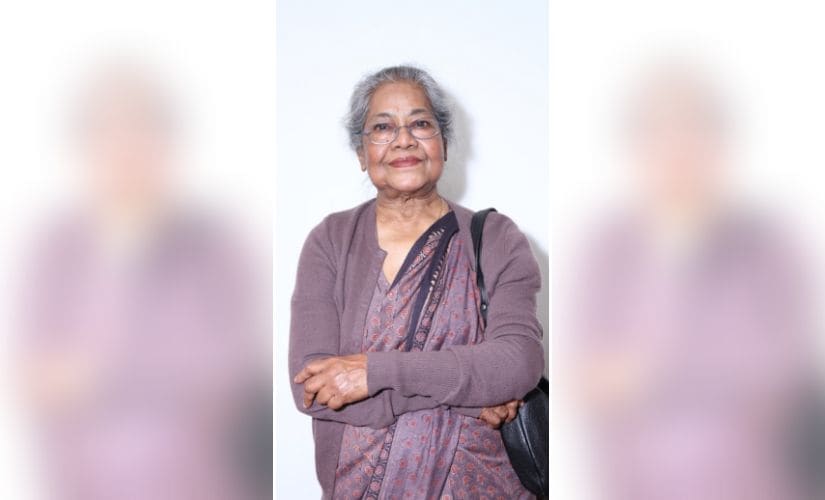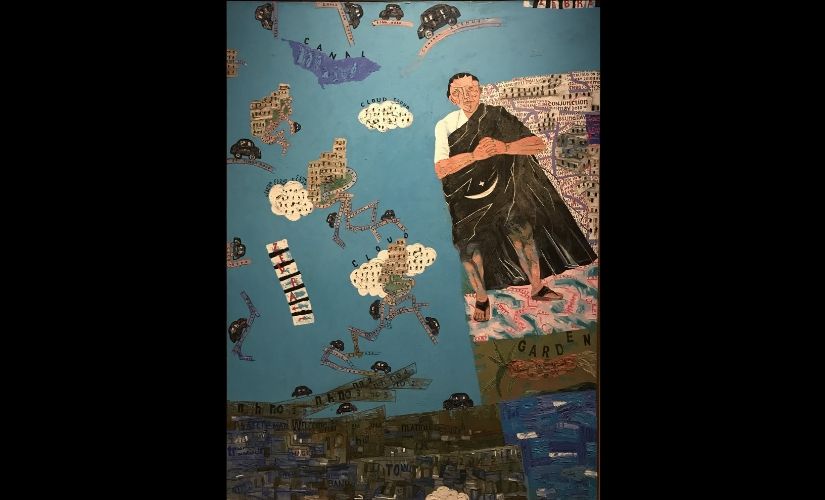Claude Monet, the legendary French Impressionist once wrote: “What keeps my heart awake is colourful silence”. The silence in Arpita Singh’s paintings is whimsical, the colour often in contrast with the deep silence of its many elements. A typical Singh painting has floating figures, human bodies, clothed or naked, references to text, history and numerous other elemental improvisations. Singh’s paintings are more compositions than they are small individual works of art. You can cut pieces out of one and they would still hold the same relevance, the same burst of colours and textures. Her first solo exhibition took place in 1972, even though she has been painting and showcasing her work since the 60s. As one of the foremost artists in Indian history, Singh’s place, though incontestable, is still due popular recognition. A mammoth retrospective of her works, titled ‘Submergence: In the Midst of Here and There’, hopes to finally change that. [caption id=“attachment_6849141” align=“alignnone” width=“825”]  Veteran artist Arpita Singh[/caption] The exhibition has brought together almost 100 artworks by Singh, a gargantuan effort considering just how scattered the works of the veteran artist are. “Her paintings are extremely sophisticated despite their apparent naivety…they compel you to look deeper with an alertness, as there is much that lies beneath the surface. I was drawn to this predominant idea of ‘submergence’ in Arpita’s works, with the woman protagonist in the midst of things happening around her, the ground fragmented with things surfacing here and there. It’s a woman’s world revealed through the girl child, the young and the middle aged older woman in Arpita Singh’s paintings,” Roobina Karode, curator of the exhibition, says. Singh’s works often have bodies, mostly of women, surrounded by elemental departures between narratives and emotions. ‘My mother’, for example, is a collage of different aspects of a woman’s life, things she has seen, things she has been through. [caption id=“attachment_6849151” align=“alignnone” width=“825”]  ‘Evening Sky’, by Arpita Singh[/caption] The vividness of the colours, the sharpness of each brushstroke demands one’s alertness. One can spend hours looking at a painting, not knowing where they are headed. “Arpita’s practice is far from being confrontational or centred on aggression. If anything, it is nuanced, complex, intriguing and offers us glimpses of stories not told, secrets not revealed. I personally believe that Arpita has invented a language that is very special. Compositionally, her works are rich and diverse in processing content with sub-plots, sub-themes unfolding spaces holding friction, anxiety and a feeling of being on the edge,” Karode says, when asked about whether Singh’s work should be seen as feminist. “It is a known fact that women artists have struggled to make it on their own in a male dominated art scene in India. Their extraordinary talent and will empowered them,” the curator adds. Singh was part of an artists’ group called the ‘The Unknowns’ that was formed in Delhi in the 1960s. But as was the case with pretty much each movement from that decade, the group disbanded. “Perhaps, because of strong individual temperament and distinct artistic personas. It is difficult to predict the sustainability of groups as well as whether a definite direction for Indian Modernism could have thrived through them,” Karode points out. In ways, Singh has always been an individualist, remaining true to her form and language. Her works are impossible to mistake for someone else’s, and despite their busy energy, occupy a staid visual state. There is a map-like spread to them but the depth — the sheer number of things happening on the canvas — is beguiling, considering how they respond to things we touch every day, from tables to photo frames. [caption id=“attachment_6849161” align=“alignnone” width=“825”]  ‘Lesser Myth’, by Arpita Singh[/caption] Assembling work that is not only years apart, but unpredictable in composition, cannot be done without a clear vision. “The exhibition presents clusters or groupings that focus on the domestic setting of her paintings amidst familiar objects and spaces, where the dining table is a recurrent feature, or the neurotic landscapes of the city, where everything feels out of place. And then we have paintings mapping new forms of social terrorism with police encounters, racial profiling, violent mobs, gang rapes and murders where budding flowers turn into bleeding bullet shots, with victims hiding and culprits lunging free,” Karode explains. Singh’s work comments on a number of everyday things, and in between life and death her art spawns like drops of paint oozing out of a canvas. [caption id=“attachment_6849171” align=“alignnone” width=“825”]  ‘My Mother’, by Arpita Singh[/caption] Karode says she has always had a lot to learn from her conversations with Singh, who turned 82 this year. “I have had several conversations with Arpita_ji_ over the years, and have found her wit and satire most appealing as she narrates anecdotes that may not have a direct bearing on the subject of her work, but would provide clues in decoding her paintings that are loaded with content,” she says. Karode believes, that despite her daunting experience and legacy, Singh is collaborative and doesn’t burden the curator at all. “Each time we met, there were revelations that left me amazed. She is an extraordinary artist to work with,” she says. As for the work itself, Karode believes there is nothing else that matches up to its indisputable originality and dramatic composition. “The interface of life and death and its casualness is most unsettling.” All photographs courtesy of KNMA The exhibition is on display at the Kiran Nadar Museum, Delhi
Artist Arpita Singh’s retrospective exhibition brings together her poignant works that are compositionally varied, yet rich in their meaning and silences, bringing together a host of themes based on her observations, memories, and experiences.
Advertisement
End of Article


)
)
)
)
)
)
)
)
)



